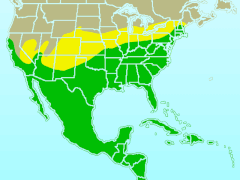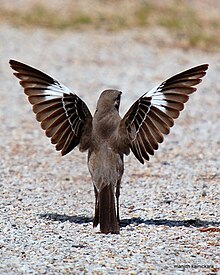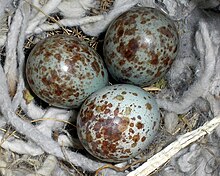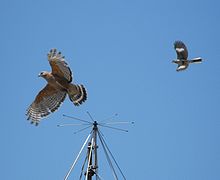Northern mockingbird
| Northern Mockingbird | |
|---|---|

| |
| Scientific classification | |
| Kingdom: | |
| Phylum: | |
| Class: | |
| Order: | |
| Family: | |
| Genus: | |
| Species: | M. polyglottos
|
| Binomial name | |
| Mimus polyglottos (Linnaeus, 1758)
| |

| |
| Northern Mockingbird range Green = all year, yellow = summer only | |
The Northern Mockingbird, Mimus polyglottos, is the only mockingbird commonly found in North America. This species was first described by Linnaeus in his Systema naturae in 1758 as Turdus polyglottos.[2]
The Northern Mockingbird breeds in southeastern Canada, the United States, northern Mexico, the Bahamas, the Cayman Islands and the Greater Antilles. It is replaced further south by its closest living relative, the Tropical Mockingbird. The Socorro Mockingbird, an endangered species, is also closely related, contrary to previous opinion.[3][4] The bird is the state bird of Arkansas, Florida, Mississippi, Tennessee and Texas.[5]
This bird is mainly a permanent resident, but northern birds may move south during harsh weather. This species has occurred in Europe as an extreme rarity.

Diet
Northern Mockingbirds eat mainly insects in summer but switch to eating mostly fruit in fall and winter. These birds forage on the ground or in vegetation; they also fly down from a perch to capture food. They mainly eat insects, berries and seeds. They’ve been seen drinking sap from the cuts on recently pruned trees. While foraging they frequently spread their wings in a peculiar two-step motion to display the white patches. There lacks consensus among ornithologists over whether this behavior is purely a territorial display, or whether the flashing white patches startles insects into giving up their cover.
Mockingbirds' willingness to nest near houses, their loud and frequent songs, and their territorial defense often annoy people. John van der Linden, author of the Eastern Birding Central FAQ, reported 25 to 50 percent of the e-mail questions he received were concerned with how to deal with annoying mockingbirds.
Habitat
Mockingbirds have a strong preference for certain trees such as maple, sweetgum, and sycamore. They generally avoid pine trees after the other trees have grown their leaves. Also, they have a particular preference for high places, such as the topmost branches of trees. Mockingbirds are often found in urban and suburban areas, where they perch on telephone poles, streetlights, or high points on buildings. While singing on a high perch they will often bolt several feet into the air in a looping motion, with wings outstretched to display their white underside, then land back on the perch without breaking a note. This has been studied and thought to be a courtship display.
Breeding


Northern Mockingbird males establish a nesting territory in early February. If a female enters his territory, the male will pursue the female with initial aggressive calls and, if she becomes uninterested, with softer calls. Once the pair is established, their song becomes more gentle. Northern Mockingbirds tend to be monogamous, and the female may return to the same male from the previous season.
Both the male and female Northern Mockingbird are involved in the nest building. The male does most of the work while the female perches on the shrub or tree where the nest is being built to watch for predators. The nest is built approximately 3 to 10 feet above the ground. The outer part of the nest is composed of twigs while the inner part is lined with grasses, dead leaves, moss or artificial fibers. The eggs are a light blue or greenish color and speckled with dots.[6] Approximately three to five eggs are laid by the female, and she incubates them for nearly two weeks. Once the eggs are hatched, both the male and female feed the chicks.
The birds aggressively defend their nest and surrounding area against other birds and animals. When a predator is persistent, mockingbirds from neighboring territories, summoned by a distinct call, may join the attack. Other birds may gather to watch as the mockingbirds harass the intruder. In addition to harassing domestic cats[7] and dogs they consider a threat, it is not unheard of for mockingbirds to target humans. They are absolutely unafraid and will attack much larger birds, even hawks (see image on right). One famous incident in Tulsa, Oklahoma involving a postal carrier resulted in the distribution of a warning letter to residents.[8]
Song and calls

Although many species of bird imitate other birds, the Northern Mockingbird is the best known in North America for doing so. It imitates not only birds but also other animals and mechanical sounds such as car alarms. As convincing as these imitations may be to humans, they often fail to fool other birds, such as the Florida Scrub-Jay.
The Northern Mockingbird's mimicry is likely to serve as a tool for increasing the size of its repertoire and thus its ability to attract females. The mockingbird is limited to imitating short units of sound, which it repeats several times before moving on to a new sound. As a result, the mockingbird sounds much better (to a human ear) imitating some species than others. Species with repetitive songs, such as the Carolina Wren, are effectively copied, but species with long, complex songs, such as the Song Sparrow, cannot be effectively imitated by the mockingbird.
Northern Mockingbirds, in addition to being good mimics, are also some of the loudest and most constantly vocal of birds. They often sing through the night or when the moon is full. This is especially true of those bachelor males that are trying to attract a female. They sing year-round except sometimes for the late-summer molting season. Individual males have repertoires of 50 to 200 songs; females sing as well, but more quietly and less often than males. Mockingbirds usually sing the loudest in the twilight of the early morning when the sun is on the horizon.
In addition to its well-known song, the Northern Mockingbird uses a variety of calls to communicate specific information. As with its song, these calls are among some of the louder sounds produced by birds of its size. Mockingbirds make a harsh, raspy noise when chasing other birds out of their territory. A similar but distinct call is used when defending against predators like a hawk or falcon. Other calls include a wheezing noise, a "chuck" note, and a very piercing series of notes "high low" repeated twice.
Intelligence
In 2009 it was reported that mockingbirds could pick out a threatening person from a crowd. Researchers had one person stand near a mockingbird nest and touch it, while other people avoided the nest. Later on, the mockingbirds recognized the intruder and attacked him, while ignoring the other people.[9]
In culture

- This is the state bird of Arkansas, Florida, Mississippi, Tennessee and Texas.
- It features in the title and central metaphor of the novel To Kill a Mockingbird, by Harper Lee. In that novel, mockingbirds are portrayed as innocent and generous, and two of the major characters, Atticus Finch and Miss Maudie, say that it is a sin to kill a mockingbird because "they don't do one thing for us but make music for us to enjoy. They don't eat up people's gardens, don't nest in corncribs, they don't do one thing but sing their hearts out for us".[10]
- The traditional American lullaby "Hush Little Baby" has been recorded in numerous musical styles. The lyrics refer to the fact that Northern Mockingbirds were once popular as pets and begin:
- Hush little baby, don't say a word,
- Mama's gonna buy you a mockingbird.
- And if that mockingbird don't sing,
- Mama's gonna buy you a diamond ring.
- President Thomas Jefferson had a pet mockingbird named Dick.[11][12]
- On the television show, Mister Rogers Neighborhood, the puppet character of King Friday XIII has a pet mockingbird (a wooden bird on a stick) whose name is Mimus Polyglottos.
Gallery
-
Taking shelter from the rain in a Weeping Holly tree
-
Adult feeding a chick
-
In flight
-
One Day old
-
Five days old
References
- ^ Template:IUCN2006 Database entry includes justification for why this species is of least concern
- ^ Template:La icon Linnaeus, C (1758). Systema naturae per regna tria naturae, secundum classes, ordines, genera, species, cum characteribus, differentiis, synonymis, locis. Tomus I. Editio decima, reformata. Holmiae. (Laurentii Salvii). p. 169.
T. obscure cinereus, subtus pallide cinereus, macula alarum albida
- ^ Hunt, Jeffrey S. (2001). "Molecular systematics and biogeography of Antillean thrashers, tremblers, and mockingbirds (Aves: Mimidae)". Auk. 118 (1): 35. doi:10.1642/0004-8038(2001)118[0035:MSABOA]2.0.CO;2. Retrieved 2007-07-28.
{{cite journal}}: Cite has empty unknown parameter:|month=(help); Unknown parameter|coauthors=ignored (|author=suggested) (help) - ^ Barber, Brian R. (2004). "Systematic position of the Socorro mockingbird Mimodes graysoni". Journal of Avian Biology. 35 (3): 195. doi:10.1111/j.0908-8857.2004.03233.x.
{{cite journal}}:|access-date=requires|url=(help); Cite has empty unknown parameter:|month=(help); Unknown parameter|coauthors=ignored (|author=suggested) (help) - ^ "Northern mockingbird." Handbook of Texas. Retrieved on March 13, 2010.
- ^ http://www.birds.cornell.edu/AllAboutBirds/BirdGuide/Northern_Mockingbird_dtl.html#food
- ^ Earth Journal: Gray Catbird Story and illustration by Gary Pendleton Bay Weekly: The Chesapeake's Independent Newspaper Online Volume 12, Issue 23, June 3–9, 2004. Accessed April 10, 2008
- ^ Wild bird warning: Mockingbird stalks mail carrier By Michael Overall 6/22/2007 from Tulsa World. Accessed April 10, 2008
- ^ Top 100 Stories of 2009 #87: Mockingbirds Know Who You Are... And They Hold a Grudge, Discover magazine, from the January–February 2010 special issue; published online December 19, 2009
- ^ Lee, Harper (1960). To Kill a Mockingbird (50th Anniversary (2010) ed.). HarperCollins. p. 148. ISBN 0061743526.
- ^ Life in the White House: Life in the State Dining Room from Whitehouse.Gov Accessed April 10, 2008
- ^ Bernstein, R. B. (2005). Thomas Jefferson. Oxford University Press. p. 140. ISBN 0-19-518130-1. Retrieved 2011-01-22.
External links
- All About Birds: Northern Mockingbird from the Cornell Laboratory of Ornithology
- Northern Mockingbird videos, photos & sounds on the Internet Bird Collection
- Northern Mockingbird Information - South Dakota Birds and Birding
- Northern Mockingbird - Mimus polyglottos - USGS Patuxent Bird Identification InfoCenter
- Learn Bird Songs: Songs of the Northern Mockingbird from the Lang Elliott website Learnbirdsongs.com
- Northern Mockingbird Bird Sound






